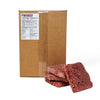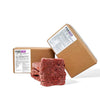As a responsible pet parent, you want the best for your dog, and choosing the right type of food is one of the most important decisions you’ll make.
For many dog owners, the choice often comes down to raw dog food or kibble. Each has its advantages and disadvantages, but when it comes to supporting your dog’s health and aligning with their natural biological needs, raw dog food stands out as the superior option. In this blog, we’ll explore the key differences between raw food and kibble, focusing on factors such as nutritional content, digestibility, and overall benefits for your dog’s health.
1. Nutritional Content: A Raw Advantage
When it comes to nutrition, raw dog food provides a more biologically appropriate diet compared to kibble. Dogs are carnivores by nature, meaning their bodies are designed to thrive on meat, bones, and organs—foods that mimic what they would consume in the wild. Here’s how raw food stacks up:
-
High-Quality Protein: Raw dog food is packed with high-quality protein from muscle meat, organs, and bones, which are essential for muscle development, energy, and overall vitality. Kibble, on the other hand, often uses lower-quality protein sources, like meat meals, which can be less bioavailable to your dog.
-
Natural Fats: Raw food includes healthy fats that come from animal sources, providing essential fatty acids like omega-3s and omega-6s. These fats are crucial for maintaining a shiny coat, supporting cognitive function, and keeping the skin healthy. Kibble often contains unhealthy fats, including plant-based oils, which can be less beneficial for your dog’s overall health.
-
Minimal Processing: Raw dog food is minimally processed, meaning the nutrients in the meat, bones, and organs are preserved in their natural form. In contrast, kibble is highly processed, which can cause a loss of vital nutrients, such as vitamins, minerals, and enzymes, that your dog needs for optimal health.
2. Digestibility: Raw Wins for Easy Digestion
One of the most significant advantages of feeding your dog raw food is improved digestion. Raw food is far easier for dogs to digest, primarily because it aligns more closely with their natural diet. Here’s why:
-
Enzymes and Natural Ingredients: Raw food contains natural enzymes that assist in the digestive process, helping your dog absorb nutrients more efficiently. These enzymes are destroyed during the cooking process used in kibble production, making it harder for your dog’s body to break down and absorb the nutrients in kibble.
-
Easier on Digestion: Many kibble diets include ingredients that dogs struggle to process, which can contribute to bloating, gas, and general digestive discomfort. Raw feeding, on the other hand, is based on meat, bones, and organs—foods that match a dog’s natural biology and are much easier for them to break down.
-
Smaller Stool Volume: Because raw meals are highly digestible and nutrients are better absorbed, dogs on a raw diet usually produce smaller, firmer stools. This is a sign their bodies are making full use of what they’re eating, unlike with heavily processed diets that often pass through without being fully utilized.
3. Benefits for Health: A Shiny Coat, Healthy Weight, and More
The benefits of feeding raw food go beyond better digestion. When dogs eat a raw diet, they experience improvements in several key health areas:
-
Shiny Coat and Healthy Skin: One of the most noticeable differences in dogs that eat raw food is their coat and skin. The healthy fats and oils in raw food nourish the skin and coat, making it shinier and softer. Dogs on a kibble diet may suffer from dry, flaky skin due to the lack of essential fatty acids and the presence of unhealthy fats in the kibble.
-
Healthy Weight Management: Raw food is packed with protein and low in carbohydrates, making it ideal for maintaining a healthy weight. Kibble, on the other hand, often contains high levels of carbohydrates that can lead to weight gain, obesity, and other health problems.
-
Improved Energy and Vitality: Dogs fed a raw diet often show higher energy levels because the food is nutrient-dense and easy for their bodies to absorb. With real, whole ingredients fueling them, their systems run more efficiently—leading to better overall health, stamina, and vitality.
-
Better Dental Health: Chewing on raw bones helps to clean your dog’s teeth and gums naturally, reducing tartar buildup and preventing dental issues. In contrast, kibble doesn’t have the same teeth-cleaning benefits and can even contribute to dental problems due to its starchy, hard texture.
4. Cost: Raw Food vs. Kibble
While raw dog food often comes with a higher upfront cost compared to kibble, it’s important to consider the long-term value. Here’s why:
-
Health Benefits and Fewer Vet Visits: Dogs fed a high-quality raw food diet tend to have fewer health problems, which means fewer trips to the vet for issues like skin conditions, gastrointestinal problems, and obesity. The money saved on veterinary bills can offset the initial cost of feeding raw.
-
More Nutrient-Dense: Although raw food may be more expensive per pound than kibble, it’s more nutrient-dense, so your dog needs to eat less to get better nutrition. In the long run, you may find that you’re actually spending less by feeding raw, as your dog’s health improves, and they require fewer supplements and medications.
5. Convenience: The Convenience Factor of Kibble
One of the key selling points of kibble is its convenience. It’s easy to store, has a long shelf life, and can be fed without much preparation. However, raw food has become increasingly convenient as well, especially with the rise of raw dog food delivery services. Companies like RawFedK9 offer pre-portioned, ready-to-serve raw food that takes the hassle out of feeding your dog raw.
While kibble requires little prep time, raw food can also be convenient when delivered to your door, eliminating the need for trips to the store and allowing you to feed your dog the most nutritious option without the inconvenience.
6. Environmental Impact
An often-overlooked factor in the raw vs. kibble debate is the environmental impact. Kibble production is highly industrialized and requires the use of large amounts of energy, packaging, and other resources. In contrast, raw food companies are often more sustainable in their sourcing practices, using whole-animal products and minimizing waste. Furthermore, raw food is often made from high-quality, ethically sourced ingredients that prioritize animal welfare.
Conclusion: Why Raw Feeding Is the Best Choice
While both raw dog food and kibble have their pros and cons, raw food is the more natural, biologically appropriate choice for your dog. It offers superior nutritional content, better digestibility, and a wide range of health benefits that promote longevity and vitality. Although raw food might come with a higher upfront cost, the long-term savings on veterinary bills, as well as the improvements in your dog’s health, make it a worthwhile investment.
At RawFedK9, we believe that feeding your dog a raw diet is one of the best ways to ensure they live a long, happy, and healthy life. With the right guidance and support, transitioning to raw food is easier than ever. If you’re ready to make the switch, check out our Transition Packs and start giving your dog the raw nutrition they deserve.






